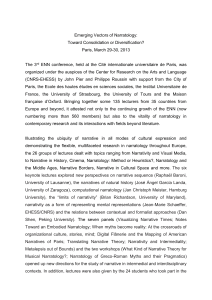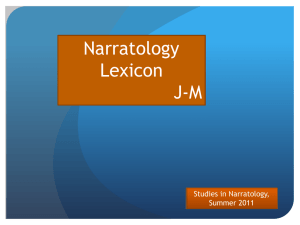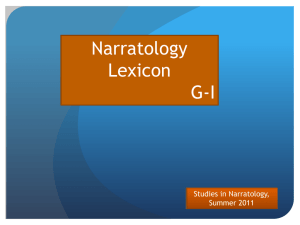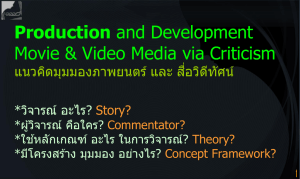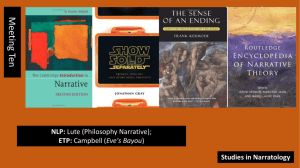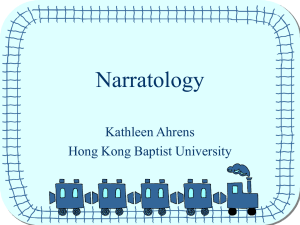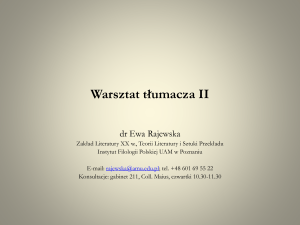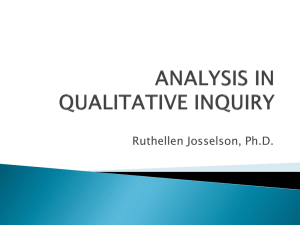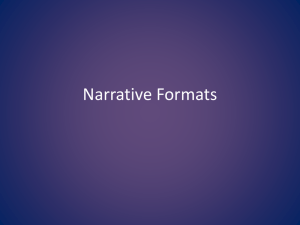Narrative Lexicon P-R
advertisement
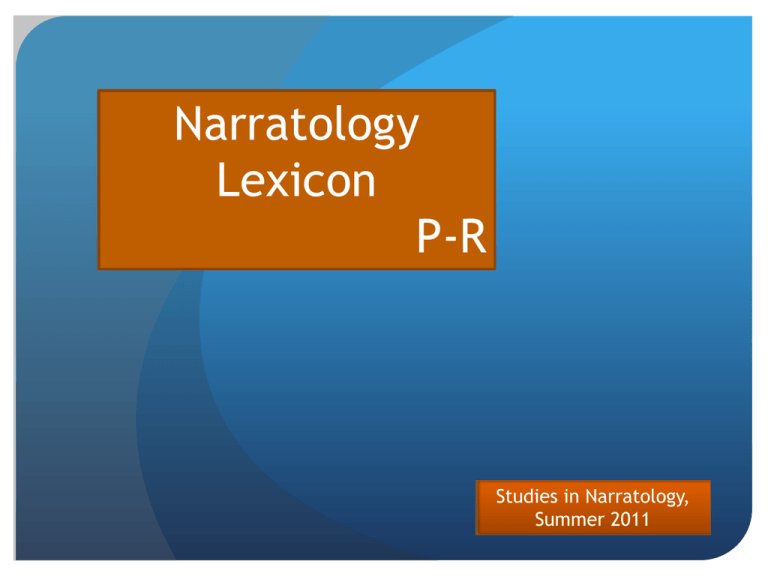
Narratology Lexicon P-R Studies in Narratology, Summer 2011 Studies in Narratology, Summer 2011 325 Studies in Narratology, Summer 2011 326 Studies in Narratology, Summer 2011 Studies in Narratology, Summer 2011 Studies in Narratology, Summer 2011 Studies in Narratology, Summer 2011 Studies in Narratology, Summer 2011 Studies in Narratology, Summer 2011 polyphonic: “Polyphony refers not literally to a number of voices, but to the collective quality of an individual utterance; that is, the capacity of my utterance to embody someone else's utterance even while it is mine, which thereby creates a dialogic relationship between two voices. For example, I quote or report someone's speech and thereby "dialogue" with his/her opinion; I appropriate the speech pattern of an admired person and associate myself with that person's linguistic-ideologic community; or I mock someone and dissociate myself from him or her. These are obvious examples, but Bakhtin further maintains that polyphony is inherent in all words or forms: "Each word tastes of the context and contexts in which it has lived its socially charged life; all words and forms are populated by intentions." [9] Linda M. Park-Fuller , “VOICES: Bakhtin's Heteroglossia and Polyphony, and the Performance of Narrative Literature” Studies in Narratology, Summer 2011 paratext: Blurbs, prefaces, authorial commentary, reviews and illustrations all qualify as paratext, which is a term coined by Gerard Genette. Part of the book and yet not part of the main narrative, paratext acts on us as readers in a way that influences how we read and interpret the main text. An author's commentary or a powerful illustration can especially influence interpretation. Studies in Narratology, Summer 2011 Studies in Narratology, Summer 2011 protagonist: The main CHARACTER; the character constituting the chief focus of interest. A narrative articulated in terms of an interpersonal conflict involves two major characters with opposite goals: the protagonist (or the HERO) and the ANTAGONIST. See: N. Friedman 1975; Frye 1957; Tomashevsky 1965. See also ANTIHERO, SUBJECT. Studies in Narratology, Summer 2011 Studies in Narratology, Summer 2011 Studies in Narratology, Summer 2011 protension (Iser): “Each sentence of a literary narrative or each shot of a television narrative both answers questions and asks new ones. Iser describes this process as an alternation between protension (expectation or anticipation) and retention (our knowledge of the text to that point). . . . According to Iser, although the text can stimulate and attempt to channel protension and retention, it cannot control those process, because both occur in the places where the text is silent—in the inevitable gaps between sentences, paragraphs, and chapters. And, I would add, in the gaps between shots, scenes, segments, and episodes. It is in these holes in the textual structure that we as readers and viewers ‘work’ on that structure. We make the connections the text cannot make for us.”—Robert C. Allen, “Reader-Oriented Criticism and Television” Studies in Narratology, Summer 2011 Studies in Narratology, Summer 2011 Studies in Narratology, Summer 2011 Studies in Narratology, Summer 2011 real author: The author (real or empirical) can be defined in a narrow sense as the intellectual creator of a text written for communicative purposes. In written texts in particular, the real author is distinguished from the mediating instances internal to the text . . . . Beyond linguistically created works, the term author is also used for works in other media such as music and the visual arts as well as for comics, photography, film, radio and television programs, and computer games. A broader understanding of the term author is used in the following contexts, among others: as conveyor of action in a socio-cultural context (cf. 2.3); in the sense of specific cultural-historically relevant conceptions of authorship; as a unifying instance in the interrelation of works (œuvre); as a reference for classification in terms of epoch and canon; and as an important point of reference for the meanings ascribed to works through which the recipient can determine the author’s intention and/or authorrelated contexts relevant to understanding a work (cf. 2.2). Studies in Narratology, Summer 2011 real reader: Studies in Narratology, Summer 2011 Studies in Narratology, Summer 2011 Studies in Narratology, Summer 2011 Studies in Narratology, Summer 2011 repeating narrative (Genette): A narrative or part thereof with a Frequency such that what happens once is recounted n times (with or without stylistic variations): "At two o'clock Mary saw Nancy! At two o'clock Mary saw Nancy! She felt really good." See: Genette 1980. Studies in Narratology, Summer 2011 retention (Iser): “Each sentence of a literary narrative or each shot of a television narrative both answers questions and asks new ones. Iser describes this process as an alternation between protension (expectation or anticipation) and retention (our knowledge of the text to that point). . . . According to Iser, although the text can stimulate and attempt to channel protension and retention, it cannot control those process, because both occur in the places where the text is silent—in the inevitable gaps between sentences, paragraphs, and chapters. And, I would add, in the gaps between shots, scenes, segments, and episodes. It is in these holes in the textual structure that we as readers and viewers ‘work’ on that structure. We make the connections the text cannot make for us.”—Robert C. Allen, “Reader-Oriented Criticism and Television” Studies in Narratology, Summer 2011 round character: A complex, multidimensional, unpredictable character, who is capable of convincingly surprising behavior. Charlus in Remembrance of Things Past is a round character. See: Forster1927. See also FLAT CHARACTER. Studies in Narratology, Summer 2011
